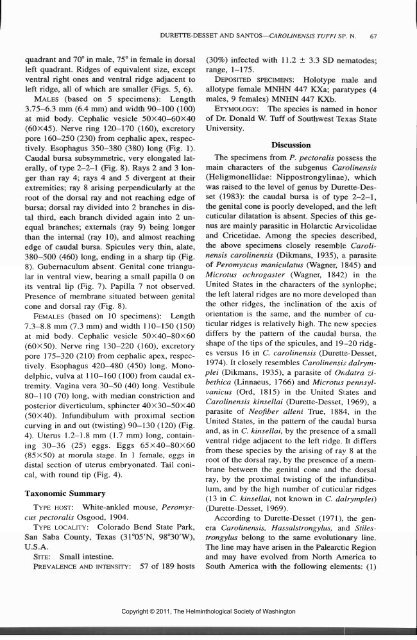Comparative Parasitology 67(1) 2000 - Peru State College
Comparative Parasitology 67(1) 2000 - Peru State College
Comparative Parasitology 67(1) 2000 - Peru State College
You also want an ePaper? Increase the reach of your titles
YUMPU automatically turns print PDFs into web optimized ePapers that Google loves.
quadrant and 70° in male, 75° in female in dorsal<br />
left quadrant. Ridges of equivalent size, except<br />
ventral right ones and ventral ridge adjacent to<br />
left ridge, all of which are smaller (Figs. 5, 6).<br />
MALES (based on 5 specimens): Length<br />
3.75-6.3 mm (6.4 mm) and width 90-100 (100)<br />
at mid body. Cephalic vesicle 50X40-60X40<br />
(60X45). Nerve ring 120-170 (160), excretory<br />
pore 160—250 (230) from cephalic apex, respectively.<br />
Esophagus 350-380 (380) long (Fig. 1).<br />
Caudal bursa subsymmetric, very elongated laterally,<br />
of type 2-2-1 (Fig. 8). Rays 2 and 3 longer<br />
than ray 4; rays 4 and 5 divergent at their<br />
extremities; ray 8 arising perpendicularly at the<br />
root of the dorsal ray and not reaching edge of<br />
bursa; dorsal ray divided into 2 branches in distal<br />
third, each branch divided again into 2 unequal<br />
branches; externals (ray 9) being longer<br />
than the internal (ray 10), and almost reaching<br />
edge of caudal bursa. Spicules very thin, alate,<br />
380-500 (460) long, ending in a sharp tip (Fig.<br />
8). Gubernaculum absent. Genital cone triangular<br />
in ventral view, bearing a small papilla 0 on<br />
its ventral lip (Fig. 7). Papilla 7 not observed.<br />
Presence of membrane situated between genital<br />
cone and dorsal ray (Fig. 8).<br />
FEMALES (based on 10 specimens): Length<br />
7.3-8.8 mm (7.3 mm) and width 110-150 (150)<br />
at mid body. Cephalic vesicle 50X40-80X60<br />
(60X50). Nerve ring 130-220 (160), excretory<br />
pore 175—320 (210) from cephalic apex, respectively.<br />
Esophagus 420-480 (450) long. Monodelphic,<br />
vulva at 110-160 (100) from caudal extremity.<br />
Vagina vera 30—50 (40) long. Vestibule<br />
80—110 (70) long, with median constriction and<br />
posterior diverticulum, sphincter 40X30-50X40<br />
(50X40). Infundibulum with proximal section<br />
curving in and out (twisting) 90-130 (120) (Fig.<br />
4). Uterus 1.2—1.8 mm (1.7 mm) long, containing<br />
30-36 (25) eggs. Eggs 65X40-80X60<br />
(85X50) at morula stage. In 1 female, eggs in<br />
distal section of uterus embryonated. Tail conical,<br />
with round tip (Fig. 4).<br />
Taxonomic Summary<br />
TYPE HOST: White-ankled mouse, Peromyscus<br />
pectoralis Osgood, 1904.<br />
TYPE LOCALITY: Colorado Bend <strong>State</strong> Park,<br />
San Saba County, Texas (31°05'N, 98°30'W),<br />
U.S.A.<br />
SITE: Small intestine.<br />
PREVALENCE AND INTENSITY: 57 of 189 hosts<br />
DURETTE-DESSET AND SANTOS—CAROL1NENSIS TUFFI SF'. N. <strong>67</strong><br />
(30%) infected with 11.2 ± 3.3 SD nematodes;<br />
range, 1—175.<br />
DEPOSITED SPECIMENS: Holotype male and<br />
allotype female MNHN 447 KXa; paratypes (4<br />
males, 9 females) MNHN 447 KXb.<br />
ETYMOLOGY: The species is named in honor<br />
of Dr. Donald W. Tuff of Southwest Texas <strong>State</strong><br />
University.<br />
Discussion<br />
The specimens from P. pectoralis possess the<br />
main characters of the subgenus Carolinensis<br />
(Heligmonellidae: Nippostrongylinae), which<br />
was raised to the level of genus by Durette-Desset<br />
(1983): the caudal bursa is of type 2-2-1,<br />
the genital cone is poorly developed, and the left<br />
cuticular dilatation is absent. Species of this genus<br />
are mainly parasitic in Holarctic Arvicolidae<br />
and Cricetidae. Among the species described,<br />
the above specimens closely resemble Carolinensis<br />
carolinensis (Dikmans, 1935), a parasite<br />
of Peromyscus maniculatus (Wagner, 1845) and<br />
Microtus ochrogaster (Wagner, 1842) in the<br />
United <strong>State</strong>s in the characters of the synlophe;<br />
the left lateral ridges are no more developed than<br />
the other ridges, the inclination of the axis of<br />
orientation is the same, and the number of cuticular<br />
ridges is relatively high. The new species<br />
differs by the pattern of the caudal bursa, the<br />
shape of the tips of the spicules, and 19-20 ridges<br />
versus 16 in C. carolinensis (Durette-Desset,<br />
1974). It closely resembles Carolinensis dalrymplei<br />
(Dikmans, 1935), a parasite of Ondatra zibethica<br />
(Linnaeus, 1766) and Microtus pennsylvanicus<br />
(Ord, 1815) in the United <strong>State</strong>s and<br />
Carolinensis kinsellai (Durette-Desset, 1969), a<br />
parasite of Neofiber alleni True, 1884, in the<br />
United <strong>State</strong>s, in the pattern of the caudal bursa<br />
and, as in C. kinsellai, by the presence of a small<br />
ventral ridge adjacent to the left ridge. It differs<br />
from these species by the arising of ray 8 at the<br />
root of the dorsal ray, by the presence of a membrane<br />
between the genital cone and the dorsal<br />
ray, by the proximal twisting of the infundibulum,<br />
and by the high number of cuticular ridges<br />
(13 in C. kinsellai, not known in C. dalrymplei)<br />
(Durette-Desset, 1969).<br />
According to Durette-Desset (1971), the genera<br />
Carolinensis, Hassalstrongylus, arid Stilestrongylus<br />
belong to the same evolutionary line.<br />
The line may have arisen in the Palearctic Region<br />
and may have evolved from North America to<br />
South America with the following elements: (1)<br />
Copyright © 2011, The Helminthological Society of Washington
















